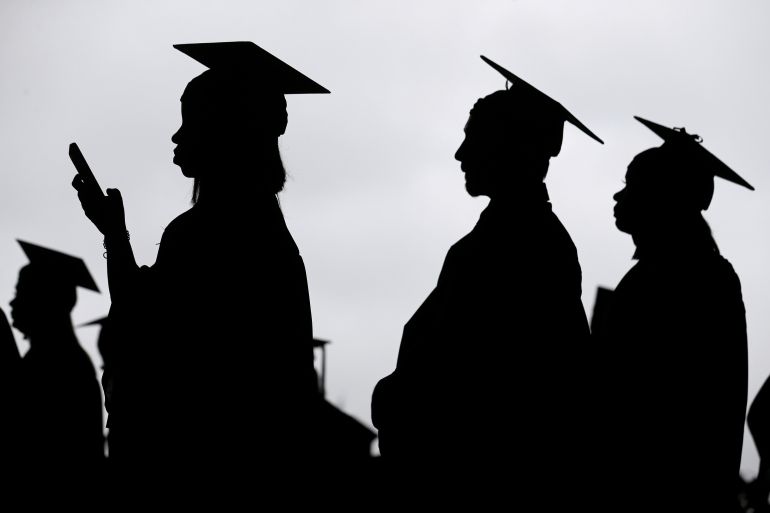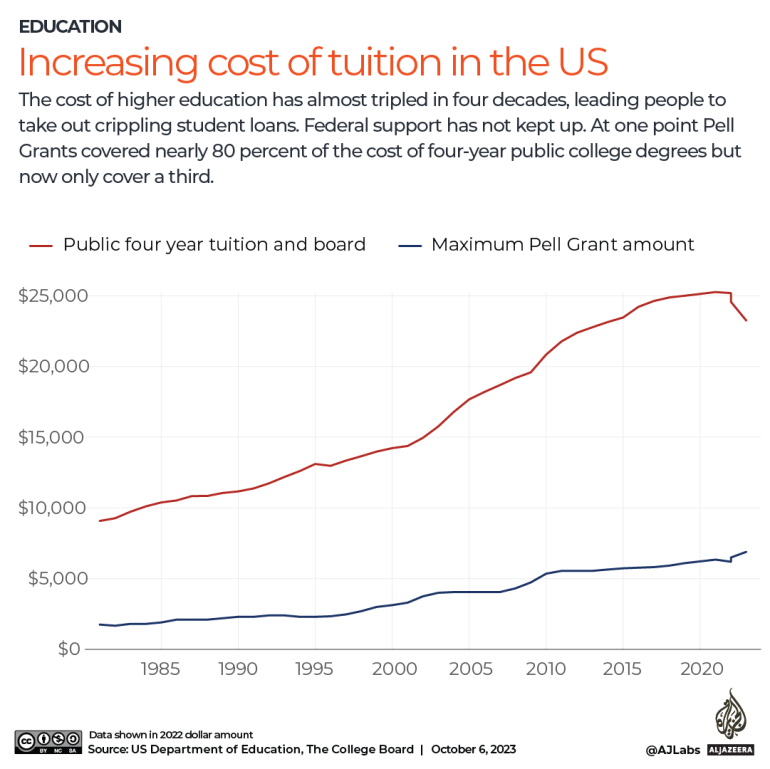Why is the Biden administration forgiving student debt?
This week Joe Biden announced debt relief worth billions of dollars for struggling graduates.

US President Joe Biden has announced a new round of federal student loan forgiveness to address the “unsustainable debt” that borrowers accumulate to complete their college education.
This move aims to help 125,000 borrowers by clearing $9bn in debt through existing programmes. Since Biden took office in 2021, a total of 3.6 million borrowers will have had $127bn in debt wiped out.
Keep reading
list of 3 itemsUS budget deficit halves, despite student loan costs
US rollback of student loan forgiveness hits borrowers, economy
“We’re not done yet,” Biden said in the Roosevelt Room at the White House on Wednesday.
Here’s what you need to know about the loan forgiveness:
Why did Biden announce this now?
Student loan repayments restarted this month after being frozen since the COVID pandemic, and the Biden administration has adjusted earlier proposals that were rejected, to help relieve student debt.
Biden has talked about pushing through reforms to education since he took office in 2021. He has said he would like make it easier for Americans to get a degree by making undergraduate programmes free, but will first tackle the debt graduates are already facing. Collectively, they owe $1.76 trillion.
Earlier in the year, the US government tried to cancel amounts of up to $20,000 for 40 million borrowers, but his move was rejected by the Supreme Court, which argued that Biden lacked the authority to push through such measures without approval from Congress.
The court’s Chief Justice John Roberts stated: “The question here is not whether something should be done; it is who has the authority to do it.”
Are debts being completely written off?
Yes, for some.
Teachers and social workers will be among the 53,000 borrowers who qualify for complete debt relief as will others enrolled in Public Service Loan Forgiveness programmes. In total, they will get $5.2bn in debt forgiveness, according to the Education Department.
People in income-dependent relief schemes, including an estimated 51,000 borrowers owing, in total, up to $2.8bn and those who are disabled borrowers with a permanent disability, making up 22,000 people owing $1.2bn.
What else is being offered?
The Biden administration plan is also offering lower monthly debt repayments for those on lower incomes.
Biden announced, “No one with an undergraduate loan today or in the future, whether a community college or a four-year college, will have to pay more than 5 percent of their discretionary income to repay these loans.”
How much has the cost of higher education increased in the US?
In 1980, it cost $10,231 a year on average for an undergraduate programme, but by 2020, it cost $28,775. Government financial grants for those most in need, known as Pell grants, have not risen to meet the increase in fees. This has led to more people taking out student loans to cover costs.

Can other groups qualify for the debt relief schemes?
The civil rights group, the National Association for the Advancement of Colored People (NAACP) wants Biden to extend debt relief to Parent PLUS loans. These are loans taken by parents to help pay for their children’s higher education.
Researchers found that 40 percent of Black graduates have student loan debt from graduate school while only 22 percent of White college graduates are in debt.
In a statement, the NAACP’s president, Derrick Johnson, said, “Historically, education has been viewed as an entry point for marginalised communities to achieve upward mobility and begin building generational wealth.
“It is unconscionable that, in their quest to provide their children with a brighter future, Black parents have fallen victim to a system that preys on their inherent disadvantage.”
Biden has repeatedly added new programmes to the growing list of initiatives to lower or cancel student loan debt over the last two years.
“My administration is doing everything we can to deliver student debt relief to as many as we can, as fast as we can,” Biden said.
What other debt relief programmes has Biden introduced?
In June this year, the Biden administration launched the Saving on A Valuable Education (SAVE) Plan. It’s an income-based repayment scheme, where borrowers earning less than $15 an hour will not have to make payments on their loans, with a chance their loans are erased.
For those earning more than $15 an hour, they will have to make monthly payments based on what they earn each month.
“This kind of relief is life-changing for individuals and their families, but it’s good for our economy, as well. By freeing millions of Americans from the crushing burden of student debt, it means they can go and get their lives in order,” Biden said.
“They can think about buying a house, they can start a business, they can be starting a family. This matters, it matters to their daily lives,” he added.
Is everyone on board with Biden’s student debt relief schemes?
Biden campaigned to make community college free, but failed to win support from Congress. Those opposed to the schemes have said this is Biden’s way of doing something similar without the need for Congressional approval.
In February this year, former Education Secretary Betsy DeVos joined others in calling Biden’s student loan forgiveness plan illegal.
“Though concerns about the rising costs of higher education and the amount of outstanding student loan debt have been part of the public discourse for decades (and long before COVID-19), the idea that the Executive Branch could unilaterally cancel student loan debt on a mass basis without Congressional authority was not seriously entertained,” DeVos said.
Others have argued that the relief unfairly passes a heavy cost onto taxpayers who already repaid their own student loans or did not seek further education.